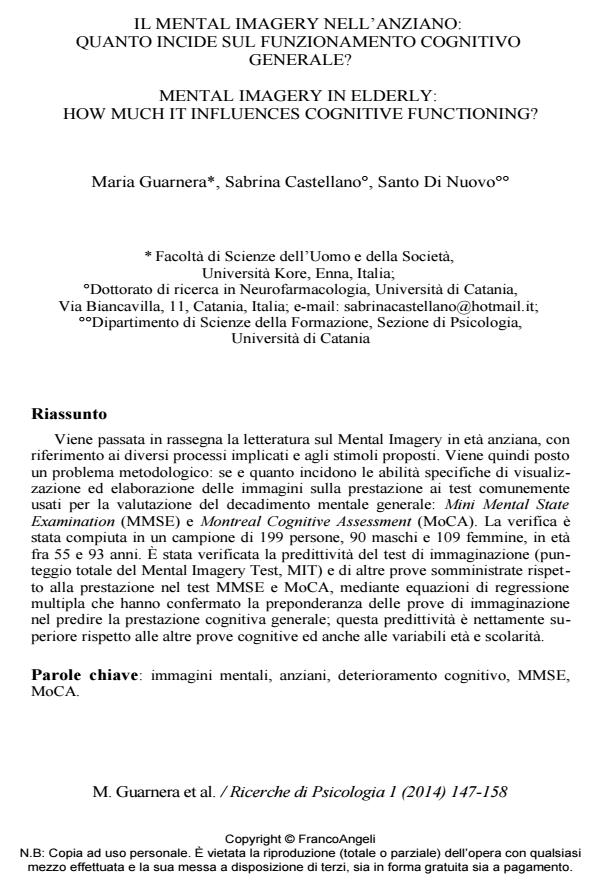Il mental imagery nell’anziano: quanto incide sul funzionamento cognitivo generale?
Titolo Rivista RICERCHE DI PSICOLOGIA
Autori/Curatori Maria Guarnera, Sabrina Castellano, Santo Di Nuovo
Anno di pubblicazione 2014 Fascicolo 2014/1
Lingua Italiano Numero pagine 12 P. 147-158 Dimensione file 181 KB
DOI 10.3280/RIP2014-001008
Il DOI è il codice a barre della proprietà intellettuale: per saperne di più
clicca qui
Qui sotto puoi vedere in anteprima la prima pagina di questo articolo.
Se questo articolo ti interessa, lo puoi acquistare (e scaricare in formato pdf) seguendo le facili indicazioni per acquistare il download credit. Acquista Download Credits per scaricare questo Articolo in formato PDF

FrancoAngeli è membro della Publishers International Linking Association, Inc (PILA)associazione indipendente e non profit per facilitare (attraverso i servizi tecnologici implementati da CrossRef.org) l’accesso degli studiosi ai contenuti digitali nelle pubblicazioni professionali e scientifiche
Viene passata in rassegna la letteratura sul Mental Imagery in eta anziana, con riferimento ai diversi processi implicati e agli stimoli proposti. Viene quindi posto un problema metodologico: se e quanto incidono le abilita specifiche di visualizzazione ed elaborazione delle immagini sulla prestazione ai test comunemente usati per la valutazione del decadimento mentale generale: Mini Mental State Examination (MMSE) e Montreal Cognitive Assessment (MoCA). La verifica e stata compiuta in un campione di 199 persone, 90 maschi e 109 femmine, in eta fra 55 e 93 anni. E stata verificata la predittivita del test di immaginazione (punteggio totale del Mental Imagery Test, MIT) e di altre prove somministrate rispetto alla prestazione nel test MMSE e MoCA, mediante equazioni di regressione multipla che hanno confermato la preponderanza delle prove di immaginazione nel predire la prestazione cognitiva generale; questa predittivita e nettamente superiore rispetto alle altre prove cognitive ed anche alle variabili eta e scolarita.
Parole chiave:Immagini mentali, anziani, deterioramento cognitivo, MMSE, MoCA.
- Immagine mentale e deficit visivi Giulia Santoro, in RICERCHE DI PSICOLOGIA 1/2014 pp.173
DOI: 10.3280/RIP2014-001010 - Le capacità immaginative nei musicisti Anita Angelica, in RICERCHE DI PSICOLOGIA 1/2014 pp.111
DOI: 10.3280/RIP2014-001006
Maria Guarnera, Sabrina Castellano, Santo Di Nuovo, Il mental imagery nell’anziano: quanto incide sul funzionamento cognitivo generale? in "RICERCHE DI PSICOLOGIA " 1/2014, pp 147-158, DOI: 10.3280/RIP2014-001008